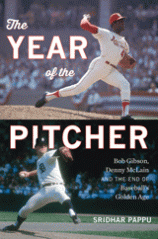The Year of the Pitcher: Bob Gibson, Denny McLain, and the End of Baseball's Golden Age
Review
The Year of the Pitcher: Bob Gibson, Denny McLain, and the End of Baseball's Golden Age
Contrary to what writers would have you believe, there is no one “Golden Age” of sports. For me, it’s whenever the perceiver believes it was, usually when you’re a kid, looking up to your heroes and thinking in your childish naïveté that if you had the opportunity you would play for nothing (the end of innocence comes when you learn about contract disputes, substance abuse, off-the-field activities, etc.).
“The Year of the Pitcher” is the nickname given to the 1968 baseball season --- right in the middle of my own “golden age” --- when craftsmen such as Denny McLain of the Detroit Tigers and Bob Gibson of the St. Louis Cardinals led their fellow hurlers as they dominated the sport thanks to some new rules. McLain became the first to win 30 games (he finished with 31) since the legendary Dizzy Dean accomplished the feat in 1934. Gibson led the Majors with an earned run average of 1.12 (fourth-best on the all-time list) while winning 21, striking out 268 batters, and completing an astounding 28 of 35 games, one more than all pitchers in the National League combined in 2017. Only six hitters in the Majors managed to hit above the .300 mark. Home runs and runs batted in were similarly low.That seminal season is marvelously --- if somewhat sadly --- chronicled by Sridhar Pappu in THE YEAR OF THE PITCHER.
"To be honest, THE YEAR OF THE PITCHER sucks a lot of the joy out of the game of my youth. Pappu wonders in several chapters if baseball was still relevant in the face of more serious problems. It’s a theme that returns to every generation."
Those two stars are the main focus of the book, but Pappu --- who writes “The Male Animal” column for The New York Times --- features other issues taking place in America at that time and their impact on baseball, including the assassinations of Martin Luther King, Jr. and Bobby Kennedy and the racial unrest they exacerbated. Pappu covers a lot more than your standard seasonal recap, and this seems to be an increasingly popular genre, with writers like Michael Leahy (THE LAST INNOCENTS: The Collision of the Turbulent Sixties and the Los Angeles Dodgers) commentating on how outside factors affected baseball, just as they did the rest of society.
McLain, a cocky guy who ran afoul of the law in later years, was a good representative of that ’60s generation, which fought back against “the establishment” and the older generation on many fronts. Gibson, on the other hand, was often depicted as the “angry black man” because of his scowling demeanor, yet he was surprisingly political and reticent to discuss racial issues, despite suffering indignities throughout his career. Oddly, his St. Louis Cardinals were relatively enlightened in that regard, as black, white and Hispanic players came together as a unit rather than fall into individual cliques.
Baseball changed dramatically in 1969. New teams were added, leading to divisional play and an additional postseason series to get into the World Series. No longer would you be guaranteed that the two best teams would meet in the Fall Classic. The rules were also changed, lowering the pitcher’s mound, thereby removing a good deal of the advantages the hurlers enjoyed the previous season.
To be honest, THE YEAR OF THE PITCHER sucks a lot of the joy out of the game of my youth. Pappu wonders in several chapters if baseball was still relevant in the face of more serious problems. It’s a theme that returns to every generation. For example, look at how the game has changed in recent years, with all its bells and whistles in a new “fan experience” designed to attract people to the ballpark who might not actually be interested in baseball. Plus, in an attempt to make things more exciting, the powers that be have changed the composition of the ball, leading to more home runs with the philosophy that high-scoring games are “better” than pitchers’ duels.
But perhaps the dour parts of the book are the point. While the world was burning down around us, there might have been more important things to consider than a bunch of overgrown kids in short pants running around a ballfield. On the other hand, it’s times like these when we need some distractions. Should we be allowed to keep our memories without having to deal with the sometimes awful truths?
Reviewed by Ron Kaplan on October 13, 2017
The Year of the Pitcher: Bob Gibson, Denny McLain, and the End of Baseball's Golden Age
- Publication Date: October 3, 2017
- Genres: History, Nonfiction, Sports
- Hardcover: 400 pages
- Publisher: Houghton Mifflin Harcourt
- ISBN-10: 0547719272
- ISBN-13: 9780547719276





